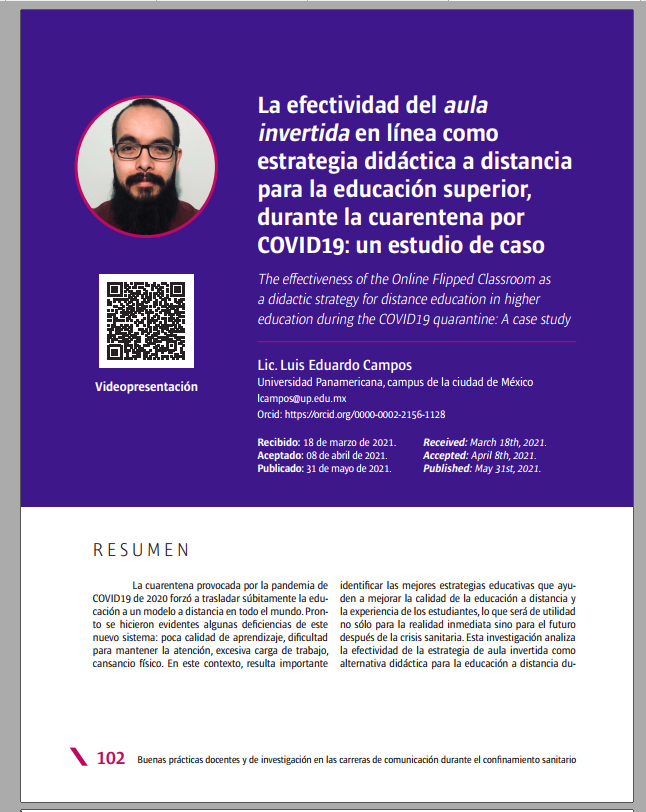The effectiveness of the Online Flipped Classroom as a didactic strategy for distance education in higher education during the COVID19 quarantine: A case study
Main Article Content
Abstract
The quarantine motivated by the 2020 COVID pandemic forced education to adapt to an online model in very little time. Soon, many deficiencies of this change became evident: poor quality of learning, difficulties to maintain attention in class, excessive workload, and physical burnout. In this context, it is important to identify the best educational strategies that help to improve both the quality of online education and the students’ experience, which will be useful not only for this immediate situation but for the post pandemic future as well. This research analyzes the effectiveness of the flipped classroom model as a didactic alternative for online education during the quarantine, in university students. After an experience of one semester in a flipped classroom model, students reported positive results in quality of learning, workload perception, learning satisfaction, and increased interest in learning, among other indicators.
Article Details
References
Flipped Learning Network (2014). https://flippedlearning.org/definition-offlipped-learning/
Gasparini, S. (2020). Design and assessment of flipped instruction: A study of student learning and perceptions in higher education. Form@ reOpen Journal per la formazione in rete, 20(1), 220-236.
Gaughan, J. E. (2014). The flipped classroom in World History. The History Teacher, 47(2), 221–244.
Gisondo, C. M., Weiner, G., & Stanley, K. (2021). A Video and Case-Based Transport Curriculum for Neonatal-Perinatal Medicine Trainees Using a Flipped Classroom Methodology. MedEdPORTAL : The Journal of Teaching and Learning Resources, 17, 11097. https://doi-org.upmx.idm.oclc.org/10.15766/mep_2374-8265.11097
Gordon, N. (2014). Flexible pedagogies: Technology-enhanced learning. The Higher Education Academy, 1-24. Jiang, M. (2020, April 22). Video chat is helping us stay employed and connected. But what makes it so tiring – and how can we reduce ‘Zoom fatigue’? British Broadcasting Corporation (BBC). https://www.bbc.com/worklife/article/20200421-why-zoom-videochats-are-so-exhausting
Guraya, S. (2020). Combating the COVID-19 outbreak with a technology-driven e-flipped classroom model of educational transformation. Journal of Taibah University Medical Sciences, 15(4), 253-254. https://doi.org/10.1016/j.jtumed.2020.07.006
Haave, H., & Vold, T. (2020). E-Learning and Online Quizzing: Pedagogical Effects of the Corona Crisis. Proceedings of the European Conference on E-Learning, 229–234. https://doi-org.upmx.idm.oclc.org/10.34190/EEL.20.036
Hew, K. F., Jia, C., Gonda, D. E., & Bai, S. (2020). Transitioning to the “new normal” of learning in unpredictable times: pedagogical practices and learning performance in fully online flipped classrooms. International Journal of Educational Technology in Higher Education, 17(1), 1–22. https://doi-org.upmx.idm.oclc.org/10.1186/s41239-020-00234-x
INEGI. (2020). “Matrícula escolar por entidad federativa según nivel educativo, ciclos escolares seleccionados 2000/2001 a 2019/2020”. https://www.inegi.org.mx/app/tabulados/interactivos/?pxq=Educacion_Educacion_06_f01706d9-f5eb-4dc5-b37a-00a792c37944
Lopez-Perez, M. V., Perez-Lopez, M. C., & Rodriguez-Ariza, L. (2011). Blended learning in higher education: Students’ perceptions and – 105 – their relation to outcomes. (Report). Computers & Education, 56(3), 818–826. https://doi.org/10.1016/j.compedu.2010.10.023
O’Flaherty, J., & Phillips, C. (2015). The use of flipped classrooms in higher education: A scoping review. The Internet and Higher Education, 25, 85-95.
Onecha Pérez, B., & Berbegal Mirabent, J. (2020). La versatilidad del método de la clase invertida: Estudio de un caso de aplicación durante la crisis de la covid-19.
Revista de Docencia Universitaria, 18(2), 49–66. https://doi-org.upmx.idm.oclc.org/10.4995/redu.2020.14419
Petersson, J., Hatakka, M., & Chatzipetrou, P. (2020). Students Perception on Group Workshops: A Comparison Between Campus-Based and Online Workshops.
Proceedings of the European Conference on E-Learning, 397–405. https://doi-org.upmx.idm.oclc.org/10.34190/EEL.20.070
Roy, H., Ray, K., Saha, S., & Ghosal, A. K. (2020). A Study on Students’ Perceptions for Online Zoom-app based Flipped Class Sessions on Anatomy Organised during the Lockdown Period of COVID-19 Epoch. Journal of Clinical & Diagnostic Research, 14(6), 1–4. https://doi-org.upmx.idm.oclc.org/10.7860/JCDR/2020/44869.13797
Singh, S., & Arya, A. (2020). A hybrid flipped-classroom approach for online teaching of biochemistry in developing countries during Covid-19 crisis. Biochemistry and Molecular Biology Education : A Bimonthly Publication of the International Union of Biochemistry and Molecular Biology, 48(5), 502–503. https://doi-org.upmx.idm.oclc.org/10.1002/bmb.21418
Smith, R. (2020). Flipped Learning during a Global Pandemic: Empowering Students with Choice. International Journal of Multidisciplinary Perspectives in Higher Education, 5(1), 100–105
Talbert, R. (2017). Flipped learning: A guide for faculty teaching face-toface, online, and hybrid courses. https://ebookcentral.proquest.com
Van Alten, D., Phielix, C., Janssen, J., Kester, L. (2019). Effects of flipping the classroom on learning outcomes and satisfaction: A meta-analysis. Educational
Research Review, (28), https://doi.org/10.1016/j.edurev.2019.05.003
Wanner, T., & Palmer, E. (2015). Personalising learning: Exploring student and teacher perceptions about flexible learning and assessment in a flipped university course. Computers & Education, 88, 354.


